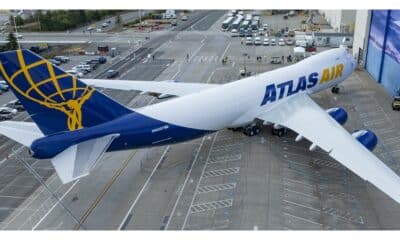Aerospace
Boeing 747 jet clocked up just 42 hours in the sky is scrapped

A Boeing 747-8 that is ten years old and has fewer than 30 hours of flight time is being destroyed. Since Saudi Arabia ordered this massive airplane in 2008—the first of its kind to be disassembled—it has lived alone and in isolation.
The queen of the sky was an order placed by the government for Crown Prince Sultan Bin Abdulaziz, but it was unfortunately delivered before he passed unexpectedly in 2011. According to Aerotelegraph, the plane arrived at the Basel-Mulhouse-Freiburg airport five months later, or towards the end of 2012. The lengthy search for a buyer began after the jet was parked.
The Boeing 747 is the world’s first jumbo plane. It has set countless records and is known as the “Queen of the Skies.” Due to reduced demand, this aircraft’s market presence decreased over time.
The majority of Boeings are utilized for commercial passengers, but only a few are used for private jets. Only a select few can afford a private jet like the B747. This airplane was purchased for US $252 million by the Saudi royal family.
[adinserter block="3"]
This plane, which has only flown 42 hours, appears to be on its way to being SCRAPPED after ten years of inactivity. Saudi Crown Prince Sultan bin Abdulaziz Al Saud bought the unusual all-white 747-8. but he died one year before the plane was scheduled to be delivered to him in 2012.
Despite having only 29 flying hours and 16 flights under its belt, the aircraft’s $95 million sale attempt failed to generate any interest. Despite several attempts to sell the airplane at the $95 million price, which, according to Aerotime, was one-fifth of the new plane’s value at the time, it remained unused for ten years at the Swiss airport.
https://www.facebook.com/Aircraft-Engineering-1948751018687991/photos/pcb.3056434764653823/3483824015180676
[adinserter block="2"]
The aircraft was purchased by AFG Ireland in July 2019 and its return to The Boeing Company was announced in April 2022. According to FlyinginIreland, the aircraft was transported for storage on April 15 from Basel to Marana, Arizona.
The magnificent craft was supposed to be bin Abdulaziz’ private jet until he died while the plane was being outfitted with a sumptuous VIP cabin in Basel, Switzerland. It has already made what could be its final journey to Pinal Airpark in Arizona, USA, a world-famous airplane boneyard where obsolete planes are dismantled for scrap.
https://www.facebook.com/Aircraft-Engineering-1948751018687991/photos/pcb.3056434764653823/3483823975180680
End of Queen of the Skies production, Boeing 747
The world’s least-flewn 747 has been delivered to Arizona’s Marana desert, where it will most certainly be demolished. The plane took off from Basel, Switzerland, on Friday, April 15th, and landed 11 hours later in Arizona, according to flight tracking data. Pinal County Airpark, located near Marana, is an aviation “boneyard” where planes are demolished and harvested for parts.
[adinserter block=”3″]
N458 BJ has only spent 42 hours in the air over its whole life. When you consider that a typical 747 might fly for over 100,000 hours before being decommissioned, it’s a little number.
[adinserter block="2"]
The 747 Supertanker is ceasing operations
More than 1,500 747s have been delivered since its debut in February 1969, with more than 500 remaining in service.
Since the 1990s, American presidents have flown Air Force One, the reigning president’s personal aircraft known as ‘the President’s office in the sky,’ aboard specially prepared 747s.
British airways says goodbye first last 747 jumbo jets

Aerospace
Which is bigger 777x or 787 aircraft ?

The 777X is a new series of the Boeing 777 family and is designed to be larger and more efficient than its predecessor. It features two variants: the 777-8 and the 777-9, being the larger of the two.
The Boeing 777X emerges as the larger sibling within the Boeing family, representing a significant leap forward in both size and efficiency. Comprising two variants, the 777-8 and the 777-9, the latter takes the crown as the larger of the two. With its expansive fuselage and impressive wingspan, the 777X is tailored for long-range journeys and boasts a substantial passenger capacity.
On the other hand, the Boeing 787, affectionately known as the Dreamliner, occupies a niche in the market as a smaller yet formidable aircraft designed for medium to long-range flights. Its distinguishing feature lies in its composite fuselage, a technological marvel that renders it lighter and more fuel-efficient compared to conventional aluminum counterparts. The Boeing 777X is larger than the Boeing 787 aircraft.
When it comes to passenger capacity, the 777-9 reigns supreme, typically accommodating a sizeable contingent of 400-425 passengers in its standard configuration. In contrast, the 787, with its more modest dimensions, typically carries between 240-290 passengers, depending on the variant and layout.
One of the remarkable innovations introduced with the 777X is its folding wingtips, a feature designed to address the logistical challenges of accommodating such a large aircraft in conventional airport gates. These folding wingtips enable the 777X to retract its wings, allowing it to fit into gates designed for smaller aircraft while still reaping the benefits of an extended wingspan during flight, thereby enhancing fuel efficiency and operational flexibility
Aerospace
China Secures Production Certificate for Mass Production of Pilotless eVTOL Aircraft

The first passenger-carrying pilotless electric vertical takeoff and landing (eVTOL) aircraft in the world, the EH216-S, has received the Production Certificate for its eVTOL aircraft from the Civil Aviation Administration of China (CAAC).
This is a significant milestone for EHang Holdings Limited, the leading UAM technology platform company in the world. This outstanding accomplishment is another big step towards mass manufacturing for the eVTOL aircraft and the ensuing commercial operations, building on the ground-breaking acquisition of the Type Certificate and the Standard Airworthiness Certificate for the EH216-S.
The PC is a crucial certificate that the aircraft maker receives from the CAAC, the country’s aviation authority. By obtaining this certificate, EHang has demonstrated that it has set up a quality management system for mass production that satisfies the airworthiness regulation standards set forth by the CAAC, and the company has been given permission to continue producing mass quantities.
It is also a strong guarantee of the calibre of the goods made by EHang. Raw materials, supplier management, manufacturing organisation, production quality control, aircraft pre-delivery test, after-sales repair and maintenance, etc. are all included in the mass production quality management system for the EH216-S.
To ensure that every aircraft and its components that roll off the production line strictly adhere to the approved type design and safety requirements, the system sets clear guidelines and documentation for every step in the production procedure. This ensures comprehensive traceability and safety control.
Aerospace
Four Airbus A380 Superjumbos lined up to be scrapped

In a strategic move aimed at reclaiming valuable resources from the iconic Airbus A380 aircraft, VAS Aero Services and Dr. Peters Group have announced a significant collaboration.
This partnership marks a milestone in aviation logistics and aftermarket services, with four of these colossal planes slated for teardown and redistribution of used serviceable material (USM).
The venture between VAS Aero Services, renowned for its expertise in aircraft dismantlement, and Dr. Peters Group, a prominent Germany-based investment fund management firm, underscores a commitment to sustainable aviation practices. This isn’t their first foray into scrapping A380s; their successful partnership has already seen the dismantlement of these aircraft, making them pioneers in this niche.
Under the agreement, the latest consignment brings the tally to eight A380s entrusted to VAS by Dr. Peters Group. Managing Director Christian Mailly of Dr. Peters Group emphasized the trust placed in VAS, citing their unparalleled capabilities in dismantlement and aftermarket sales network. It’s a strategic move in response to the growing demand for quality USM parts, particularly with the resurgence in reliance on the A380.
Notably, the teardown process will be carried out at various locations, optimizing the positioning of harvested parts to cater to different markets. While some parts will be positioned in Europe to support operators in the region and the Middle East, others will remain in the Asia-Pacific region. This meticulous strategy ensures efficient access to spare parts, benefiting MROs and airlines across these markets.
The decision to retire these A380s comes at a time when operators are reassessing fleet strategies amidst evolving market dynamics. Despite initial plans for quick retirement due to the emergence of more fuel-efficient alternatives, factors such as a rebound in long-haul demand and delays in new widebody deliveries have prompted operators to reconsider. The A380, with its unique capacity and capabilities, presents a practical solution for short-term capacity management.
































